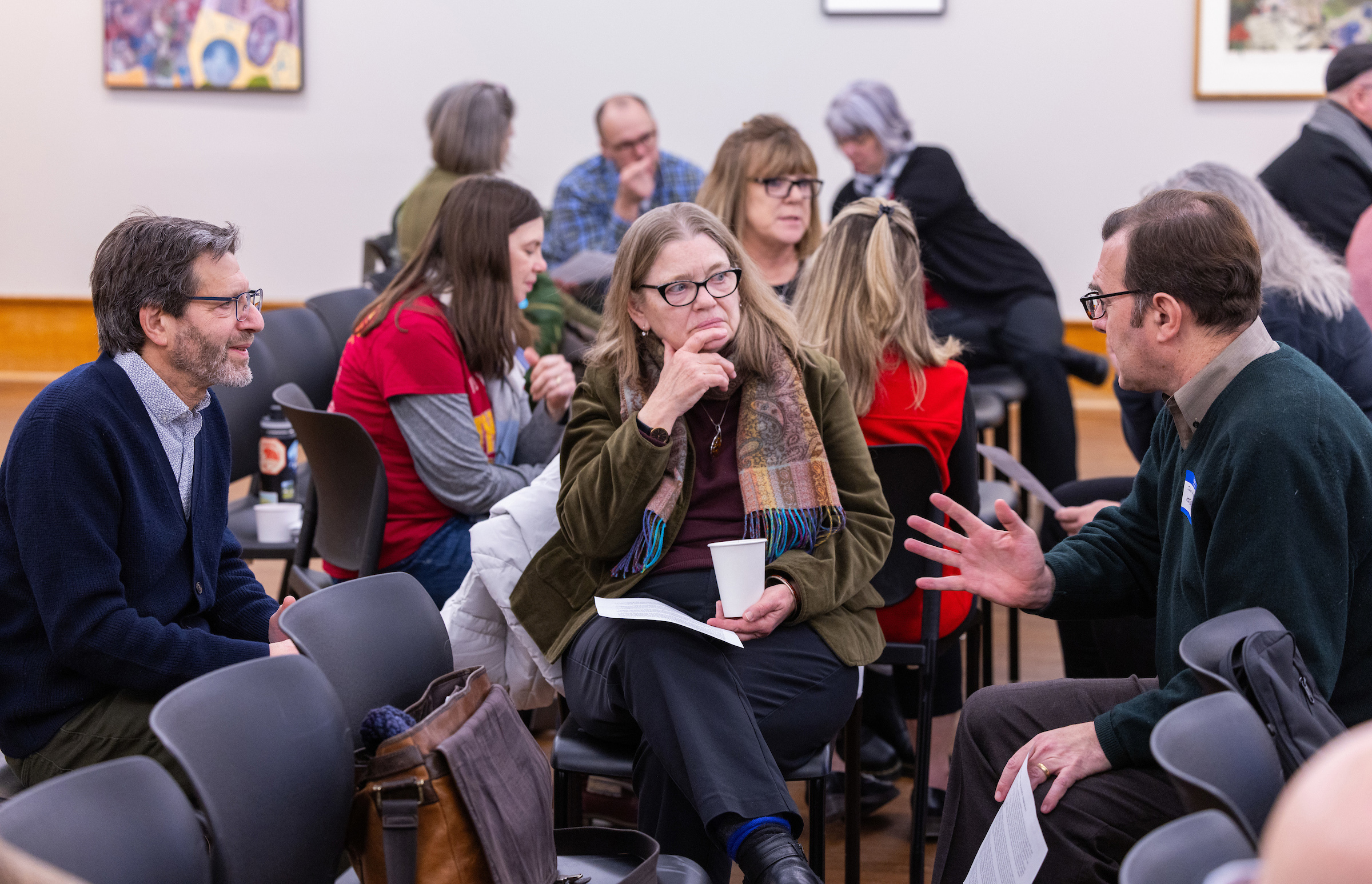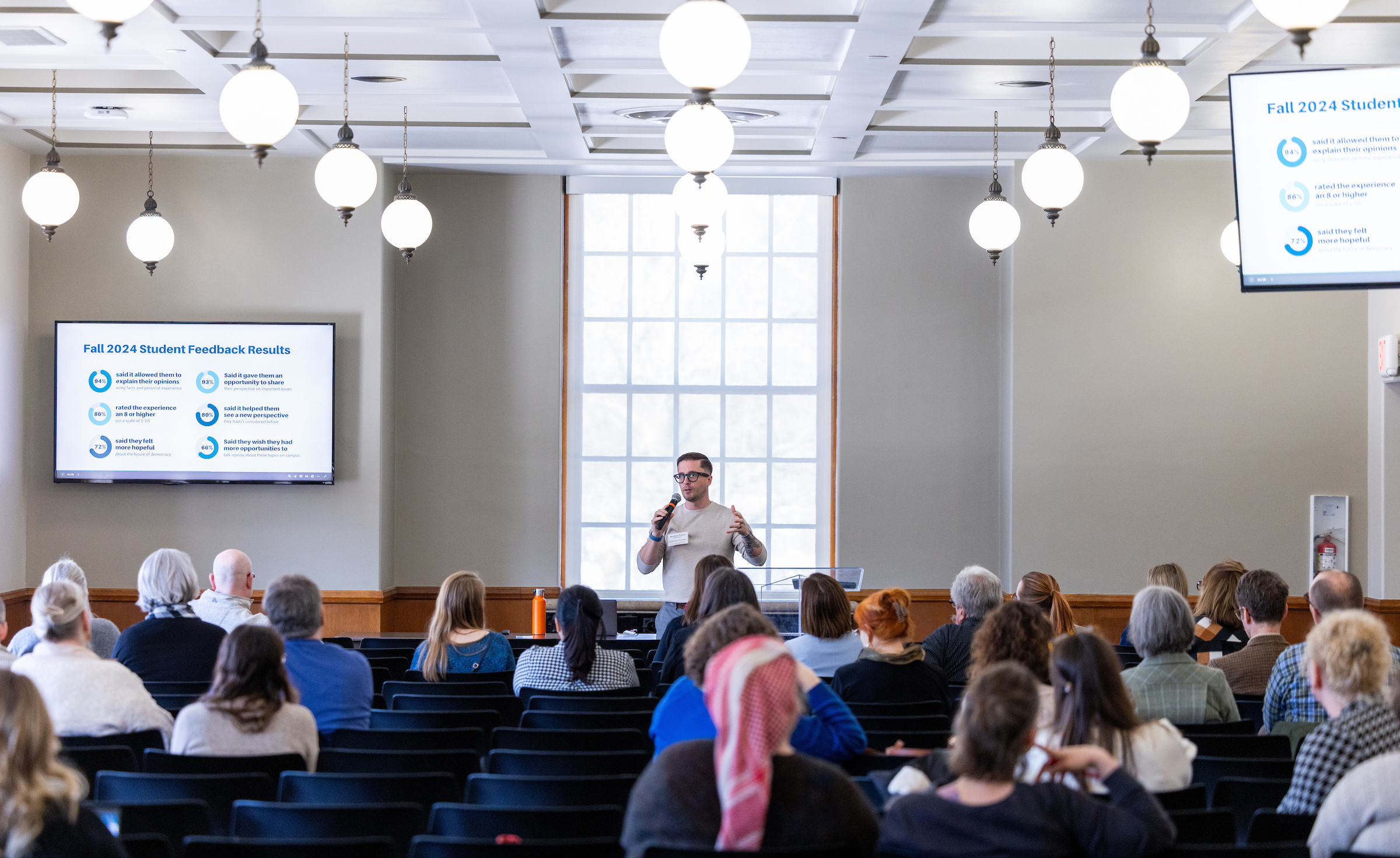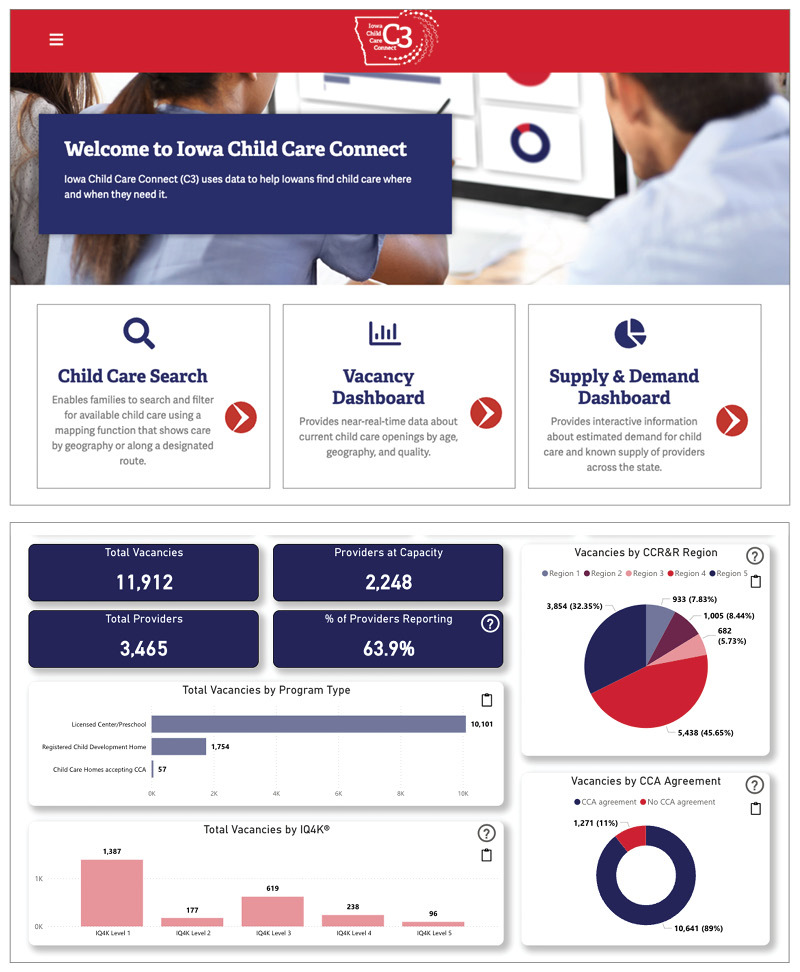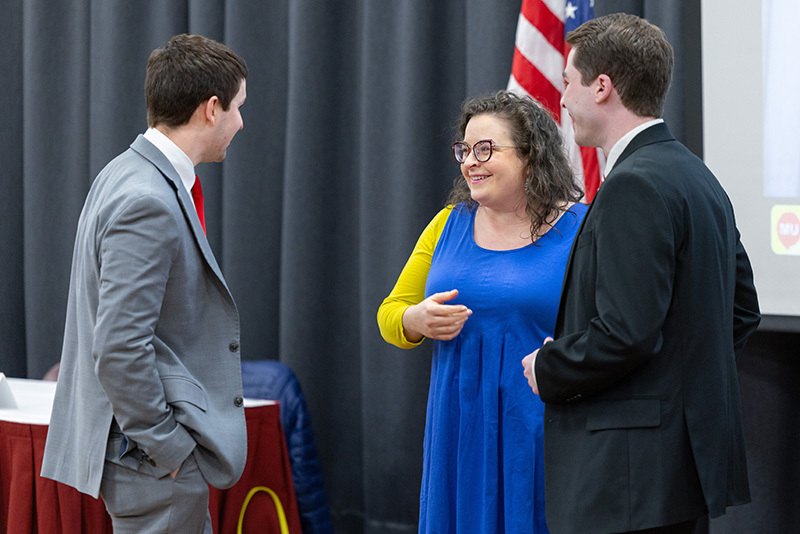Building civic skills

(foreground, l-r) Faculty members Joshua Rosenbloom, economics; Joan Chamberlin, English; and John Monroe, history, huddle during an ethics bowl practice exercise Wednesday during the Cyclone Civics professional development conference at the Memorial Union. A team from the philosophy and religious studies department introduced the ethics bowl model as a way to teach skills such as respect, listening and fair dialogue. Photos by Christopher Gannon.
More than 130 faculty and staff registered for Wednesday's Cyclone Civics professional development event at the Memorial Union. The afternoon focused on civics instruction across academic disciplines as well as in extra-curricular opportunities for students. It also served as a first opportunity to "take stock" -- to see how comfortable faculty, instructors and non-teaching staff are with the topic.
The half-day event opened with a keynote talk by Frederick Lawrence, secretary and CEO of the Phi Beta Kappa Society and a distinguished lecturer at Georgetown University Law Center, Washington, D.C. Lawrence presented civics education and free expression as the "twin commitments" of higher education in the U.S.
The conference is part of a new multi-year effort, Cyclone Civics, which addresses the Iowa Board of Regents' 2023 directive #9 that each university establish a "widespread initiative that includes opportunities for education and research on free speech and civic education." The initiative is based in the College of Liberal Arts and Sciences, with direction from political science faculty Karen Kedrowski and Kelly Shaw.
Cyclone Civics would like to co-sponsor events and high-impact student experiences that promote one or more aspects of civic education and free expression. Co-sponsorship request forms are online.

Matthew Pollard of Unify America (standing) was one of three professionals working in public or civil discourse who led a breakout session Wednesday during the Cyclone Civics professional development conference at the Memorial Union.
Proposed strategic plan edits, second 'future' degree go to regents next week
When it meets Feb. 27 at the board office in Urbandale, the Iowa Board of Regents will receive proposed changes to Iowa State's 2022-31 strategic plan. The board directed the review to comply with a 2024 state law prohibiting diversity, equity and inclusion (DEI) offices at the regent universities as well as DEI work broadly defined by the law. The open portion of the meeting is scheduled to begin at 10:30 a.m. and will be streamed on the board website. The agenda also is online.
Among the proposed edits (PDF) to Iowa State's strategic plan, the most notable is a reworking of the second of the plan's five aspirational statements: To be the university that cultivates a welcoming and respectful environment where all students, faculty and staff flourish.
The previous version read: To be the university that cultivates a diverse, equitable and inclusive environment where students, faculty and staff flourish.
Last fall, the regents asked the three regent universities to revise their strategic plans as needed to comply with the new law. In December, senior advisor to the president Sophia Magill led a 15-member committee that reviewed the 2022-31 strategic plan and recommended the changes to senior leaders.
The board approved changes to its own 2022-27 strategic plan at its January meeting.
Second 'degree of the future'
Iowa State will seek final approval for its new bachelor of science degree in integrated health sciences, led by the departments of genetics, development and cell biology and food science and human nutrition. This would be the second approved degree program in a 2022-31 strategic plan-funded initiative, Degrees of the Future. The interdisciplinary program includes coursework in life sciences, behavioral and social sciences, data science and the humanities to provide a holistic view of health care and fill unmet needs in the state and national healthcare landscapes. It offers students five tracks:
- Science of health and disease
- Human health and nutrition
- Data science and human studies
- Public policy, ethics, communications and human health
- Behavioral and mental health studies
In other degree activity, Iowa State is asking to:
- Suspend admission to the Ph.D. program in rural, agricultural, technological and environmental history, for history department budget reasons, and as the first step of a five-year sunset plan for the program.
- End the interdisciplinary master of science in transportation program, College of Engineering, due to declining student interest. No students currently are enrolled, and the last graduates were in spring 2020. Future students could apply to the civil engineering major and specialize in transportation engineering.
Parking permits won't increase this summer
The parking division is not seeking an increase to campus parking permit prices or parking fines for the budget year that begins July 1. All outstanding bonds on the ISU parking system are paid off. Permit rates for the Memorial Union (MU) parking ramp, which is operated by the MU separately from ISU's parking division, would go up 3%, as proposed. Hourly rates in the ramp would not change in FY26.
Memorial Union parking ramp: Proposed permit rates
|
Permit |
Proposed FY26 |
Current |
|
Employee/annual |
$700.40 |
$680 |
|
Fall, spring (19-20 weeks) |
$303.85 |
$295 |
|
Winter (Nov-Feb) |
$278.10 |
$270 |
|
Summer (13 weeks) |
$251.32 |
$244 |
Change to the admissions application
As of Feb. 13, the gender selection box in the regent universities' application for admission was reduced to three options: Female, male, prefer not to answer. This change (PDF) was made following a communication to the board from members of the Legislature.
Other Iowa State requests
In other business, Iowa State leaders will seek board permission to:
- Award two honorary Doctor of Science degrees at spring graduation ceremonies. The first is to Larry Buss, alumnus, western Iowa farmer and retired chief hydrologic engineer for the U.S. Army Corps of Engineers, Omaha, in recognition of extraordinary achievements in engineering and agriculture and his work as a staunch advocate for farmers and rural communities. Faculty in the agricultural and biosystems engineering department submitted Buss' nomination. The second is to Creston native and Grammy Award winner John "JR" Robinson, the music industry's most recorded drummer (his discography includes more than 10,000 recording sessions for the music, television and film industries), in recognition of his extraordinary contributions to the music industry. Faculty in the music and theatre department nominated Robinson for the honorary degree.
- Approve a list of academic majors and high-demand jobs (PDF) (as provided by Iowa Workforce Development) eligible for the Iowa Workforce grant and incentive program for academic years 2025-26 and 2026-27. These are awards available to junior and senior in-state students at the three regent universities, for up to four semesters, with an additional $2,000 incentive payment if they accept a high-demand job aligned with their major within six months of degree completion and work fulltime in that position for 12 months. Last year (2023-24) was the first year of the program.
- Begin planning to renovate an estimated 12,000 square feet in Black Engineering Building for the mechanical engineering department. The space will be vacated this summer by the industrial manufacturing and systems engineering department's move to the Therkildsen building. The renovation would focus on research labs, offices and support spaces. The estimated $12.6 million-$14.2 million project would be funded with private gifts.
- Renovate three parking lots, including underground utility and lot lighting improvements and new sidewalks, this summer. The three lots are north of Black Engineering (lot 8), east of Atanasoff (16) and east of Physics (36). The combined $2.75 million projects will be paid for with parking and utility system funds.
- Renovate six second-floor teaching labs in the Human Nutritional Sciences Building for the Textile Science Teaching Lab, which is located temporarily in Bessey Hall during the LeBaron Hall replacement. The $2.35 million project, funded with private gifts, would locate the teaching lab next to the newly renovated Textiles Science Research Laboratory. Work would begin later this spring.
The regents also will hear short presentations Thursday on multiple required annual reports from the universities:
- (2) Academic program review, distance education, to the academic affairs committee, 11 a.m.
- Student financial aid, to the free speech and student affairs committee, 12:30 p.m.
- (3) Span of control, human resources and affirmative action, to the governance, evaluation and human resources committee (consent agenda items), 1 p.m.
- (2) Residence system governance, graduation and retention, to the full board, 2:30 p.m.
All-funds budgeting now possible in Workday
An employee team has completed a months-long project in Workday Adaptive Planning that brings budget planning and analysis for all university funds into Workday. Workday Adaptive Planning supports integrated financial planning, which allows users to create budgets, in-year forecasts, scenario analysis and other financial models. It's a more automated process, saving time and resources during the budget planning cycle.
Iowa State launched the system in April 2020 for its general fund operating budget -- roughly half of the university's overall budget. Since June, an employee team has worked to update Workday Adaptive Planning so all university funds, regardless of source, can be managed with it. The result is a seamless, interactive experience between budget teams and the central financial planning and analysis team.
Key new features include:
- Tuition and mandatory fee revenue projection models
- Budget planning for: auxiliary units, fee-for-service, ISU Foundation gifts, grants, capital projects, faculty startups and carry-forward balances
- Automated budget loading from Workday Adaptive Planning to Workday Finance
Two pieces to the ISU budget
General fund: The university operating budget
Restricted use funds: Sponsored research, endowment income, sales and service, building projects and auxiliary units (for example, athletics, residence, printing, parking, utilities, bookstore, Reiman Gardens, Memorial Union)
All funds: General fund + restricted use funds
Previously, projection models and restricted fund budgets were manually uploaded to Workday Finance, where they could be shared with a broader set of users. Employees would create Excel spreadsheets or extract data from Workday Adaptive Planning and send it to the financial planning and analysis team for manual uploading to Workday Finance. The Workday Finance report process hasn't changed, but campus users now can compare budgets to actuals across the various fund types in those reports.
Ongoing training for user group
To accommodate all-funds budgeting, additional finance employees received access to Workday Adaptive Planning, and training was provided to all users during December and January. Staff in the financial planning and analysis unit will offer additional training sessions and office help hours throughout the FY26 budget planning cycle. The project team will collaborate to develop a standardized budget reporting package for university leaders generated from Workday Adaptive Planning.
Bonnie Whalen, associate vice president for financial planning and analysis, expressed her gratitude to the team that worked on the project -- 31 employees representing various departments across campus.
"The project team has shown exceptional dedication over the past several months, investing countless hours in collaboration with campus partners, implementation consultants and project management to ensure a successful launch," Whalen said.
Questions about the Workday Adaptive Planning deployment can be sent to workday_planning@iastate.edu.
April enhancements coming to TIAA retirement plan
As benefits-eligible employees learned in a Feb. 14 email (PDF) from university leaders Sean Reeder (operations and finance) and Kristi Darr (university human resources), Iowa State is making three changes to its TIAA retirement plan in April. In addition to aligning with industry best practices, the enhancements respond to preferences employees have shared previously. The changes also are expected to save participants about $4.1 million in aggregate fees each year.
The basic design of the retirement program with TIAA will remain the same, and consultations with TIAA representatives will remain free. Likewise, contribution rates and eligibility requirements aren't changing. Benefits director Ed Holland said it's about making the retirement plan work better for participants.
"It comes down to senior leadership and EBAC (employee benefits advisory committee) looking at our plans and what we learned in the [2022] benefits survey and identifying what we can do to make our plan more attractive, not just for employees who are close to retirement, but also for people who are considering coming to Iowa State to work," he said.
The three enhancements will:
- Trim the menu of funds available to ISU participants from 45 funds to 28 funds, several of which will have lower fees. The menu still will include age-based options, which automatically adjust an individual's investments as they get closer to retirement. Forty-five fund options are well beyond industry best practice, Holland said, noting that too many choices can overwhelm participants in their decision-making.
- Introduce a self-directed brokerage account, an option not offered previously. This option lets employees select from thousands of mutual funds, including funds removed from the current menu they'd like to remain invested in. It responds to employee requests for access to more choices generally and to certain types of investment preferences.
- Move the plan's default option from lifecycle funds to a new option called Iowa State RetireOn Track, a portfolio that includes investments for guaranteed income in retirement. In a TIAA participant survey, 80% of respondents said they'd like some kind of guaranteed income in retirement that's not tied to the market. This new default option automatically manages investments, making it easier for employees to stay on track with their retirement goals.
What's next
More communication about the retirement plan enhancements will come directly from TIAA, including a packet of printed materials in March. Starting in early April, TIAA staff will lead four live webinars with plan participants as well as four on-campus seminars that include help desks staffed by TIAA representatives. In mid-April, employees will receive a confirmation email that they're enrolled in the university's new TIAA plan and then will have about a week to update their contribution choices.
University assists state with child care website

The Iowa Child Care Connect website and vacancy dashboard. Graphic by Deb Berger.
Heather Rouse and Todd Abraham -- along with their team at Iowa's Integrated Data System for Decision-Making (I2D2) -- helped the state of Iowa's Child Care Connect (C3) website launch in August, the first statewide effort in the nation to help families find near-real time child care vacancies in their area. It was an 18-month sprint for Iowa State and its partners, but Rouse, a human development and family studies associate professor, believes it's just the start.
"We are excited about what's next," she said. "Now that it is out there, we are looking for all the ways we can use the information to help the state."
C3 maps more than 3,000 child care providers across Iowa and lists information such as quality ratings, hours of operation, child age range served and whether they accept state child care assistance funds. Families can choose between home- and center-based child care and map out locations close to home or on a route to work or school. The site does not display the rates that providers charge, but has contact information for each business.
Rouse and her team knew how to build data systems and had agreements in place for data sharing, data storage and the staff to operate the new project. That head start saved more than two years in developing C3, she said.
Eight years ago, Rouse began the I2D2 project with Abraham, the assistant director of data and analytics. I2D2 is a partnership between ISU and state departments that combines data from education and health and human services for analytics and strategic planning to improve outcomes for Iowa children and families. It helps find gaps in services, measures the effectiveness of programs and informs policies that support children and families.
"When the governor's task force on child care provided recommendations for improving Iowa's child care system in 2021, several of the recommendations related to data and how to make information more readily available to families," Rouse said. "With what we had done with the I2D2 project, we already had the foundation of information we needed to start work on the Child Care Connect system."
The I2D2 team and ISU information technology services and information technology security partnered with the Iowa Department of Health and Human Services (HHS) and a technology consulting firm, Resultant, to build the site. Through a contract with the state, ISU maintains the data, technology infrastructure and website.
C3 draws significant interest from other states looking to do something similar, Rouse said. Iowa HHS leadership and the ISU team have presented on C3 at multiple conferences and fielded a plethora of questions about the process of building the website and its results.
Early results
The website receives hundreds of hits each month, with use steadily growing, Rouse said. C3 incorporates data from multiple sources including the state's licensing and registration data, child care management systems at each business and Iowa's Child Care Resourse and Referral network data system. Providers also can respond to a monthly reporting tool that updates their vacancy information by ages.
"The vacancy dashboard shows the number of providers who have submitted updated data," Rouse said. "We are seeing participation rates in the 60-70% range, and it is in their best interest to tell us when they have vacancies. If you don't communicate with the system within 60 days it assumes you are full. It's a way for them to advertise, and several have noted they are getting spots filled quicker."
Rouse said not only does C3 help ensure day care providers fill spots, but it helps communities and the state identify areas of need. The state has more than 177,000 children in child care.
The next level
A "wish list" is being compiled of possible expansions to the next version of C3. The team will meet next month with the work group that assisted through the planning and implementation phases of the website to discuss ways the system can be advanced.
"In all the work we do with our state partners, we try to think about how we can make an investment in something that will serve multiple purposes," she said. "So now the question is 'what else can it do?'"
Faculty Senate, student government hold first joint meeting

Faculty senate president-elect Meghan Gillette (center) visits with student government president Martin Hursh (left) and vice president Quinn Margrett before a joint meeting of the two groups in the MU Sun Room on Monday. Photo by Christopher Gannon.
The Sun Room looked similar to a lot of Faculty Senate meetings on Monday evening, but this gathering was anything but routine. At their first-ever joint meeting, members of the Faculty Senate and student government discussed topics and shared perspectives for more than an hour.
Prior to Monday night, student government representatives had met with senators only to serve on Faculty Senate councils or committees. Student government does have a joint meeting with the Ames City Council every semester.
More than 30 students and 11 members of the Faculty Senate discussed four preset topics:
- The rise of hybrid learning
- Micro-credentials
- Multiple majors, minors or concurrent degrees
- Artificial intelligence in the classroom
Faculty learned about student concerns and strengths students see at Iowa State and faculty shared the reasons behind the decisions they make with their classes.
Hybrid learning drew the most in-depth conversation with students having mixed reactions. Some appreciated the opportunities it provided to fit courses into their schedule while others struggled, especially with group projects. Faculty stressed hybrid learning does not work for all courses, citing science labs or design studios. Others felt they couldn't make meaningful connections with students -- some who turned off their cameras during lectures -- to enhance learning.
"We want this to be an opportunity to build a stronger relationship with the Faculty Senate and provide real input into academic policy being considered at Iowa State," said student government president Martin Hursh.
Faculty Senate president Rahul Parsa concluded the discussion by thanking students for presenting their ideas and getting involved. He said he hoped the joint meetings could continue in the future.
